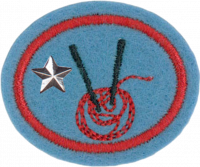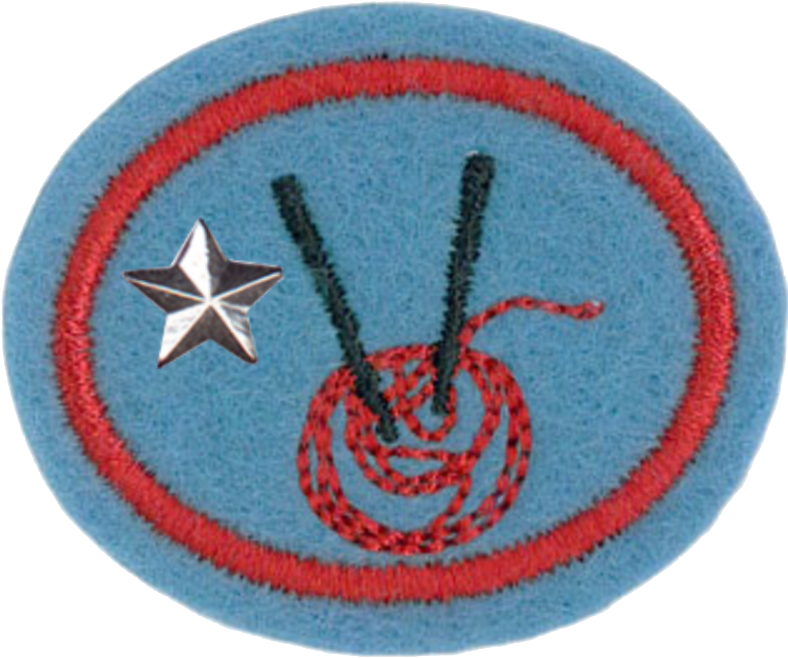Difference between revisions of "AY Honors/Knitting - Advanced/Answer Key 2/en"
From Pathfinder Wiki
< AY Honors | Knitting - AdvancedAY Honors/Knitting - Advanced/Answer Key 2/en
(Updating to match new version of source page) |
(Updating to match new version of source page) |
||
| Line 1: | Line 1: | ||
{{HonorSubpage}} | {{HonorSubpage}} | ||
<section begin="Body" /> | <section begin="Body" /> | ||
| − | {{ansreq|page={{#titleparts:{{PAGENAME}}|2|1}}|num=1}} | + | {{ansreq|page={{#titleparts:{{PAGENAME}}|2|1}}|num=1|page=AY Honors/Knitting - Advanced/Requirements 2}} |
<noinclude></noinclude> | <noinclude></noinclude> | ||
<!-- 1. Have the Knitting Honor. --> | <!-- 1. Have the Knitting Honor. --> | ||
| Line 8: | Line 8: | ||
{{CloseReq}} <!-- 1 --> | {{CloseReq}} <!-- 1 --> | ||
| − | {{ansreq|page={{#titleparts:{{PAGENAME}}|2|1}}|num=2}} | + | {{ansreq|page={{#titleparts:{{PAGENAME}}|2|1}}|num=2|page=AY Honors/Knitting - Advanced/Requirements 2}} |
<noinclude></noinclude> | <noinclude></noinclude> | ||
<!-- 2. Knit a gauge swatch with the yarn of your choice and the needles recommended on the yarn label as follows: --> | <!-- 2. Knit a gauge swatch with the yarn of your choice and the needles recommended on the yarn label as follows: --> | ||
| Line 15: | Line 15: | ||
{{CloseReq}} <!-- 2 --> | {{CloseReq}} <!-- 2 --> | ||
| − | {{ansreq|page={{#titleparts:{{PAGENAME}}|2|1}}|num=3}} | + | {{ansreq|page={{#titleparts:{{PAGENAME}}|2|1}}|num=3|page=AY Honors/Knitting - Advanced/Requirements 2}} |
<noinclude></noinclude> | <noinclude></noinclude> | ||
<!-- 3. Block your swatch and measure your gauge, does it match the recommended gauge on the yarn label? If it does not, how do you adjust? --> | <!-- 3. Block your swatch and measure your gauge, does it match the recommended gauge on the yarn label? If it does not, how do you adjust? --> | ||
| Line 22: | Line 22: | ||
{{CloseReq}} <!-- 3 --> | {{CloseReq}} <!-- 3 --> | ||
| − | {{ansreq|page={{#titleparts:{{PAGENAME}}|2|1}}|num=4}} | + | {{ansreq|page={{#titleparts:{{PAGENAME}}|2|1}}|num=4|page=AY Honors/Knitting - Advanced/Requirements 2}} |
<noinclude></noinclude> | <noinclude></noinclude> | ||
<!-- 4. Why is it important that your gauge matches a pattern in making clothing? --> | <!-- 4. Why is it important that your gauge matches a pattern in making clothing? --> | ||
| Line 29: | Line 29: | ||
{{CloseReq}} <!-- 4 --> | {{CloseReq}} <!-- 4 --> | ||
| − | {{ansreq|page={{#titleparts:{{PAGENAME}}|2|1}}|num=5}} | + | {{ansreq|page={{#titleparts:{{PAGENAME}}|2|1}}|num=5|page=AY Honors/Knitting - Advanced/Requirements 2}} |
<noinclude></noinclude> | <noinclude></noinclude> | ||
<!-- 5. What is color work? Make one item that uses: Intarsia, Stranded color work or Fair Isle. --> | <!-- 5. What is color work? Make one item that uses: Intarsia, Stranded color work or Fair Isle. --> | ||
| − | |||
| − | |||
| − | |||
| − | |||
| − | |||
| − | |||
| − | |||
| − | |||
| − | |||
| − | |||
| − | |||
| − | |||
| − | |||
| − | |||
| − | |||
| − | |||
| − | |||
<noinclude></noinclude> | <noinclude></noinclude> | ||
{{CloseReq}} <!-- 5 --> | {{CloseReq}} <!-- 5 --> | ||
| − | {{ansreq|page={{#titleparts:{{PAGENAME}}|2|1}}|num=6}} | + | {{ansreq|page={{#titleparts:{{PAGENAME}}|2|1}}|num=6|page=AY Honors/Knitting - Advanced/Requirements 2}} |
<noinclude></noinclude> | <noinclude></noinclude> | ||
<!-- 6. What are cables? Make one item that uses cables. --> | <!-- 6. What are cables? Make one item that uses cables. --> | ||
| Line 60: | Line 43: | ||
{{CloseReq}} <!-- 6 --> | {{CloseReq}} <!-- 6 --> | ||
| − | {{ansreq|page={{#titleparts:{{PAGENAME}}|2|1}}|num=7}} | + | {{ansreq|page={{#titleparts:{{PAGENAME}}|2|1}}|num=7|page=AY Honors/Knitting - Advanced/Requirements 2}} |
<noinclude></noinclude> | <noinclude></noinclude> | ||
<!-- 7. Knit one of the following in the round using double pointed needles or circular needles (magic loop): Mittens, socks, fingerless gloves, wrist warmers, hat brim up with decreases. --> | <!-- 7. Knit one of the following in the round using double pointed needles or circular needles (magic loop): Mittens, socks, fingerless gloves, wrist warmers, hat brim up with decreases. --> | ||
| − | |||
| − | |||
<noinclude></noinclude> | <noinclude></noinclude> | ||
{{CloseReq}} <!-- 7 --> | {{CloseReq}} <!-- 7 --> | ||
| − | {{ansreq|page={{#titleparts:{{PAGENAME}}|2|1}}|num=8}} | + | {{ansreq|page={{#titleparts:{{PAGENAME}}|2|1}}|num=8|page=AY Honors/Knitting - Advanced/Requirements 2}} |
<noinclude></noinclude> | <noinclude></noinclude> | ||
<!-- 8. Knit a sweater that fits you or another person. --> | <!-- 8. Knit a sweater that fits you or another person. --> | ||
| Line 76: | Line 57: | ||
{{CloseReq}} <!-- 8 --> | {{CloseReq}} <!-- 8 --> | ||
| − | {{ansreq|page={{#titleparts:{{PAGENAME}}|2|1}}|num=9}} | + | {{ansreq|page={{#titleparts:{{PAGENAME}}|2|1}}|num=9|page=AY Honors/Knitting - Advanced/Requirements 2}} |
<noinclude></noinclude> | <noinclude></noinclude> | ||
<!-- 9. Knit a sweater that fits you or another person. --> | <!-- 9. Knit a sweater that fits you or another person. --> | ||
| Line 83: | Line 64: | ||
{{CloseReq}} <!-- 9 --> | {{CloseReq}} <!-- 9 --> | ||
| − | {{ansreq|page={{#titleparts:{{PAGENAME}}|2|1}}|num=10}} | + | {{ansreq|page={{#titleparts:{{PAGENAME}}|2|1}}|num=10|page=AY Honors/Knitting - Advanced/Requirements 2}} |
<noinclude></noinclude> | <noinclude></noinclude> | ||
<!-- 10. Do one of the following: --> | <!-- 10. Do one of the following: --> | ||
<noinclude></noinclude> | <noinclude></noinclude> | ||
| − | {{ansreq|page={{#titleparts:{{PAGENAME}}|2|1}}|num=10a}} | + | {{ansreq|page={{#titleparts:{{PAGENAME}}|2|1}}|num=10a|page=AY Honors/Knitting - Advanced/Requirements 2}} |
<noinclude></noinclude> | <noinclude></noinclude> | ||
<!-- a. Teach someone how to complete a basic knitting project. --> | <!-- a. Teach someone how to complete a basic knitting project. --> | ||
| Line 94: | Line 75: | ||
{{CloseReq}} <!-- 10a --> | {{CloseReq}} <!-- 10a --> | ||
| − | {{ansreq|page={{#titleparts:{{PAGENAME}}|2|1}}|num=10b}} | + | {{ansreq|page={{#titleparts:{{PAGENAME}}|2|1}}|num=10b|page=AY Honors/Knitting - Advanced/Requirements 2}} |
<noinclude></noinclude> | <noinclude></noinclude> | ||
<!-- b. Visit a nursing home or shut-in person and spend a good part of the day sharing and knitting with others. --> | <!-- b. Visit a nursing home or shut-in person and spend a good part of the day sharing and knitting with others. --> | ||
| Line 100: | Line 81: | ||
{{CloseReq}} <!-- 10b --> | {{CloseReq}} <!-- 10b --> | ||
| − | {{ansreq|page={{#titleparts:{{PAGENAME}}|2|1}}|num=10c}} | + | {{ansreq|page={{#titleparts:{{PAGENAME}}|2|1}}|num=10c|page=AY Honors/Knitting - Advanced/Requirements 2}} |
<noinclude></noinclude> | <noinclude></noinclude> | ||
<!-- c. Use knitting as a conversation starter to speak to someone about the gospel. --> | <!-- c. Use knitting as a conversation starter to speak to someone about the gospel. --> | ||
Latest revision as of 18:09, 9 December 2022
Knitting - Advanced
Skill Level
3
Year
1970
Version
29.12.2025
Approval authority
North American Division
1
Have the Knitting honor.
For tips and instruction see Knitting.
2
Knit a gauge swatch with the yarn of your choice and the needles recommended on the yarn label as follows:
- Looking at your yarn label, cast on 6 or 10 more stitches than the gauge listed making sure you have an odd number of stitches. For example, if the knitting gauge is 18 sts and 24 rows, cast on (18 +6) = 24 and one more to make it odd or 25 total.
- Row 1 RS – *K1, P1* repeat to the end of the row (ending with P1, K1)
- Row 2 WS – *K1, P1* repeat to the end of the row (ending with P1, K1)
- Row 3 RS – K1, P1, K1, P1, *K1* repeat until four stitches from the end of the row, P1, K1, P1, K1
- Row 4 WS – K1, P1, K1, P1, *P1* repeat until four stitches from the end of the row, P1, K1, P1, K1
- Repeat rows 3 and 4 until swatch measures 5 inches (12.5 cm)
- Repeat row 1 and 2
- Bind off
- Abbreviations:
- RS – Right side
- WS – Wrong side
- K1 – Knit one
- P1 – Purl one
3
Block your swatch and measure your gauge. Does it match the recommended gauge on the yarn label? If it does not, how do you adjust?
4
Why is it important that your gauge matches a pattern in making clothing?
5
What is colorwork? Make one item that uses: Intarsia, Stranded colorwork or Fair Isle.
6
What are cables? Make one item that uses cables.
7
Knit one of the following in the round using double pointed needles or circular needles (magic loop): Mittens, socks, fingerless gloves, wrist warmers, hat brim up with decreases.
8
Knit a sweater that fits you or another person.
9
Read Psalm 139 and discuss how it applies to the act of knitting.
10
Do one of the following:
10a
Teach someone how to complete a basic knitting project.
10b
Visit a nursing home or shut-in person and spend a good part of the day sharing and knitting with others.
10c
Use knitting as a conversation starter to speak to someone about the gospel.


